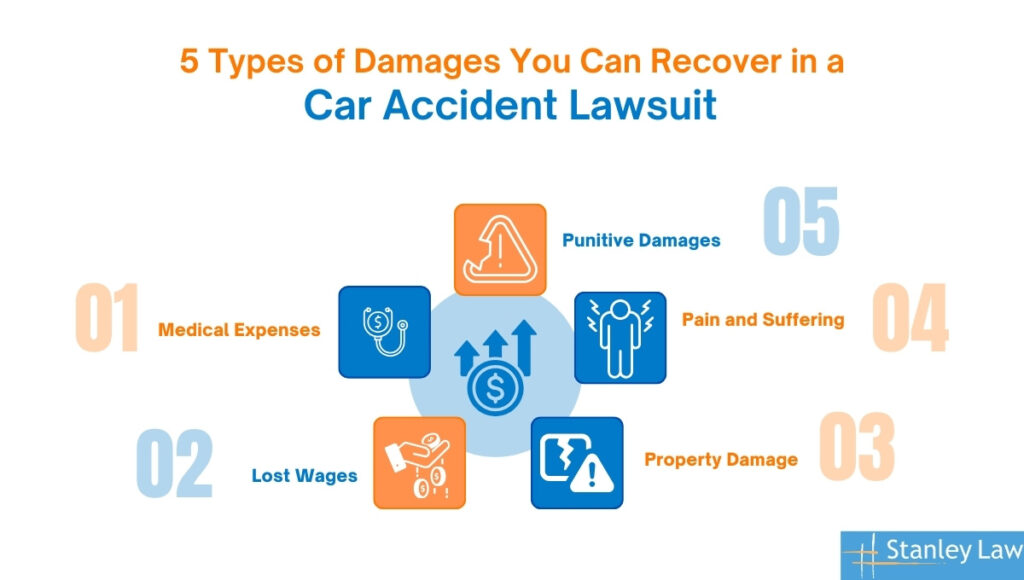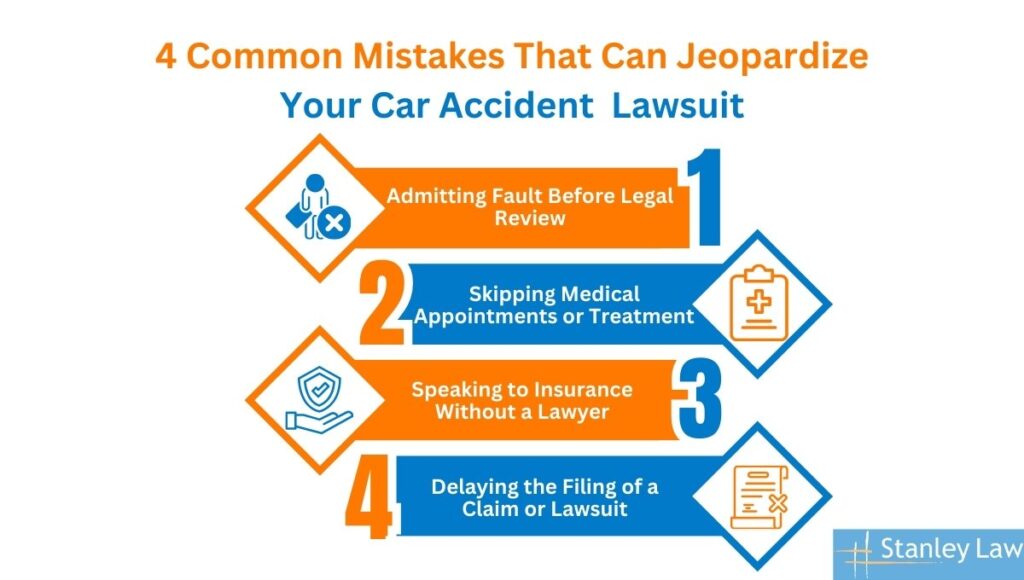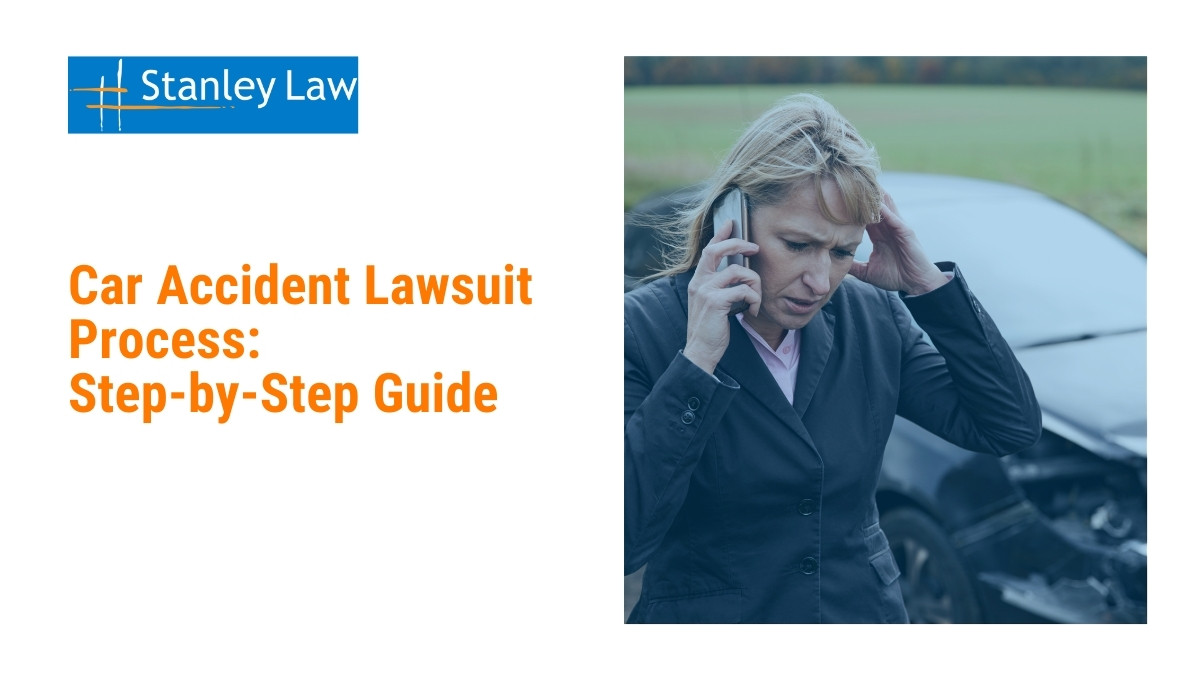The car accident lawsuit process begins when insurance fails to cover all damages incurred by a victim in their crash. This legal maneuver allows injured drivers another avenue to recover full compensation, including medical expenses, lost income, and pain and suffering.
You can file a car accident lawsuit if the at-fault driver\’s insurance company denies your claim or offers an amount that is inadequate to address your needs.
Most car accident lawsuits last between 6 to 18 months, depending on case complexity and court scheduling. During that time, you retain the right to legal counsel, fair compensation, and access to your case documents.
From Crash to Court: 9 Steps in a Car Accident Lawsuit
A car accident lawsuit follows defined steps, beginning immediately after the crash. Each stage plays a key role in securing full compensation.
Here are the 9 steps of the car accident lawsuit process.
Step 1: Seek Medical Attention and Document Every Detail
- Get medical care right away even if injuries seem minor, because some symptoms may appear hours or days later.
- Photograph and/or video record everything: vehicle damage, visible injuries, road conditions, and traffic signs.
- Collect key information from the other driver and any witnesses, including names, contact details, and insurance info.
- Keep and organize all records such as medical reports, bills, and photos, as they will be critical for supporting your legal claim.
Step 2: Report the Accident and Notify Insurance
- File a police report immediately and request a copy for your records.
- Notify your insurance company within 24–72 hours to prevent claim delays or denial.
- Submit a DMV accident report if required by your state.
- Stick to the facts when speaking with police or insurers; DO NOT speculate or admit fault.
- Document your claim details carefully and accurately, including the claim number and your adjuster’s contact information.
Step 3: Consult a Car Accident Lawyer for Legal Guidance
Many accident victims wonder if they really need a lawyer. The answer is yes: consulting a car accident attorney early can help you avoid costly mistakes and protect your rights.
An experienced lawyer can:
- Evaluate your case and advise on the best legal steps.
- Handle all communication with insurance companies.
- Gather evidence and calculate the full value of your damages.
- Work on a contingency basis, meaning you pay nothing unless you win.
Legal representation significantly improves your chances of receiving full and fair compensation.
Step 4: File a Personal Injury Claim or Lawsuit
- Start by filing a personal injury claim with the at-fault driver’s insurance company.
- If the claim is denied or undervalued, you may need to file a lawsuit in civil court.
- Claims are faster and less formal but may not cover full damages.
- Lawsuits offer stronger legal leverage when negotiations fail.
- Most states have a two-year statute of limitations for filing, and an attorney will monitor and help you ensure that all deadlines are met
Step 5: Begin Investigation and Collect Evidence
Once the lawsuit is filed, the case enters the discovery phase, where both sides gather and exchange evidence. To meet your burden of proof, you must show that the other party’s actions directly caused your injuries.
Key evidence includes:
- Police reports
- Medical records and treatment notes
- Photos or video footage from the scene
- Witness statements
- Expert evaluations, such as accident reconstruction or medical opinions
Thorough documentation strengthens your case and increases the likelihood of winning a fair settlement or verdict.
Step 6: Enter Negotiation and Attempt a Settlement
The vast majority of personal injury cases are resolved through settlement negotiations before reaching trial. Your attorney will pursue this path first, attempting to negotiate directly with the insurance company either through written offers, phone discussions, or formal mediation. Insurers often prefer to settle to avoid the risk and cost of trial.
Settlement value is influenced by:
- Severity of your injuries
- Total medical expenses
- Lost wages or earning capacity
- Insurance policy limits
An experienced NY car accident lawyer can help you pursue the maximum settlement based on precedents and calculation of the full impact of your losses.
Step 7: File the Lawsuit if No Settlement
If settlement negotiations fail, the next step is to formally file a lawsuit in court. Your attorney will prepare and submit a legal complaint outlining your claims.
The process includes:
- Filing the complaint with the appropriate court.
- Serving the defendant with legal documents.
- Receiving a case number and trial schedule from the court.
- Handling pre-trial motions, such as motions to dismiss or requests to change venue.
Filing a lawsuit keeps your claim moving forward and applies legal pressure on the opposing party to resolve the case.
Step 8: Attend Trial and Await Verdict
If no settlement is reached, your case proceeds to trial. During this stage, both sides present their arguments and evidence before a decision is made.
Key trial phases include:
- Opening statements
- Witness testimony
- Presentation of evidence
- Cross-examination
- Closing arguments
Types of trials:
Jury Trial: A group of peers determines the verdict.
Bench Trial: The judge alone decides the outcome.
Trial duration can range from a single day to several weeks, depending on the complexity of the case and the amount of evidence presented.
Step 9: Accept the Settlement or File an Appeal
If you win at trial, the court will award compensation. However, the losing party may choose to appeal, which can delay payment. If you lose, you may also have the right to file an appeal.
Key points regarding appeals:
- Strict deadlines apply, typically within 30 to 60 days of the judgment.
- Appeals focus on legal errors, not re-examining the facts of the case.
- An experienced attorney can evaluate whether an appeal is appropriate and guide you through the process.
Whether accepting a judgment or pursuing an appeal, legal guidance is essential to protect your interests and meet all procedural requirements.

Understanding the Legal Differences Between Claims and Lawsuits
After a car accident, most people first opt to initiate an insurance claim, which is the standard way to request compensation for injuries and damages. But when a car accident claim does not result in a fair outcome, filing a lawsuit is the next best step.
Here is how the two paths differ:
| Basis | Insurance Claim | Lawsuit |
|---|---|---|
| Handled by | Insurance company. | Civil court. |
| Goal | Settle for damages without court. | Seek legal judgment on fault and damages. |
| Timeframe | 2–8 weeks. | Several months to a year. |
| Process | Informal, negotiation-based. | Formal legal process with strict deadlines. |
| Cost to file | Typically free. | Filing fees, and possible court costs. |
| Legal Assistance | Optional, but helpful. | Strongly recommended. |
| Outcome | A settlement offer from the insurer. | Verdict or court-approved settlement. |
When Should You Escalate from a Claim to a Lawsuit?
- The insurer denies your claim outright.
- You are offered far less than your estimated damages.
- The at-fault party\’s insurance coverage is too low.
- The insurer delays processing your claim without reason.
- There are disputes over who caused the accident.
Common Scenarios:
- Claim example: You are rear-ended at a stoplight. The other driver’s insurer accepts fault and covers your repairs and medical bills. No lawsuit is needed.
- Lawsuit example: You suffer a concussion and back injury. The insurer delays responding then blames you partially, eventually offering you only a fraction of your medical costs. Your attorney files a lawsuit to pursue fair compensation in court.

5 Types of Damages You Can Recover in a Car Accident Lawsuit
A car accident lawsuit allows you to recover more than just vehicle repair costs. You can claim compensation for financial loss, physical harm, and emotional suffering.
Below are five major types of damages you are entitled to obtain:
Medical Expenses
These damages cover the full scope of medical care tied to your injuries, both immediately after the crash and in the weeks or months that follow. Strong medical documentation is key to supporting this claim.
Examples include:
- Emergency room visits
- Ambulance transport
- Surgery and hospital stays
- Prescription medications
- Physical therapy or rehabilitation
- Long-term care for chronic issues
Lost Wages
When your injuries limit your ability to work, you can recover the income you’ve lost and in some cases, the income you’ll lose down the road. This applies whether the impact is temporary or permanent.
Examples include:
- Missed paychecks while recovering
- Reduced hours or job duties
- Job loss due to physical limitations
- Future lost earnings if you are unable to return to your previous role
Property Damage
This covers damage to your vehicle and other personal belongings involved in the crash. Keep receipts, repair estimates, and photos to support this portion of your claim.
Examples include:
- Vehicle repair costs
- Totaled car replacement value
- Damaged phones, laptops, car seats, or other belongings that were inside the car during the accident
Pain and Suffering
These damages reflect the physical discomfort and emotional impact caused by the crash. While harder to quantify, they are an essential part of many claims.
Examples include:
- Chronic pain
- Depression or anxiety following the accident
- Loss of enjoyment of life
- Sleep issues or post-traumatic stress
Punitive Damages
These are awarded in cases involving dangerous or reckless behavior and are meant to penalize the at-fault driver. They\’re less common but can significantly increase the value of a lawsuit.
Examples include:
- Driving under the influence
- Fleeing the scene (hit and run)
- Excessive speeding or racing
- Distracted driving with clear disregard for others’ safety

4 Common Mistakes That Can Jeopardize Your Car Accident Lawsuit
Even those car accident lawsuits strongly supported by evidence can fail due to avoidable mistakes. Insurers and defense lawyers look for errors to reduce or deny your claim. Knowing what not to do is as important as understanding what to do.
Avoid these pitfalls:
Admitting Fault Before Legal Review
Do NOT make statements that suggest you were responsible.
Even simple phrases like “I should’ve slowed down” or “I didn’t see them” can be used to reduce your compensation. You do not have all the facts until the evidence is reviewed, so only discuss the fault with your car accident lawyer.
Skipping Medical Appointments or Treatment
Do NOT stop treatment or miss follow-ups.
Gaps in care suggest your injuries were not serious or that you recovered quickly. Consistent treatment creates a clear medical record, which helps prove injury severity and supports your case during settlement or trial.
Speaking to Insurance Without a Lawyer
Do NOT give detailed statements without legal guidance.
Never speak to insurance adjusters without legal guidance. Their ultimate goal is to reduce payouts, not to help you in any way. Even casual comments or recorded interviews can be used against you. Let your lawyer handle all communication to protect your rights and avoid weakening your car accident claim.
Delaying Claim Filing or Lawsuit
Do NOT wait too long to take legal action.
Most states enforce a strict deadline to file, often two years. Delays weaken evidence, blur witness memories, and may eliminate your right to sue. Act early to protect your legal and financial recovery.

Schedule a Free Consultation with a Car Accident Lawyer
If you’ve been in a serious crash, Stanley Law Offices can help. With over 90 years of combined experience among our car accident lawyer staff, we’ve recovered millions in compensation for clients across New York and Pennsylvania.
Our legal team serves Syracuse, Binghamton, Watertown and all surrounding areas across all of upstate New York. Start with a free, confidential consultation. We’ll review your case, explain your options, and guide your next steps. Call 800-608-3333 or contact us online to schedule your free case review. We’re ready when you are.
FAQs About Car Accident Lawsuits
How much compensation can I receive from a car accident lawsuit?
Payouts for common car accidents typically fall within the range from $15,000 to $100,000 or more, depending on injury severity and damages. Cases involving permanent disability or long-term care can exceed those amounts by a multiple of five or more.
Can I file a car accident lawsuit without hiring a lawyer?
Yes, but it is not advised. Without legal help, you may miss deadlines, undervalue your case, or mishandle procedures that could cost you compensation. Find out more reasons to get a lawyer after a car accident.
How long does a car accident lawsuit process take?
Most cases take several months to a year. If settled early, they may resolve in 3–6 months. Complex cases or trials may take longer.
Is a traffic claim the same as a lawsuit?
No. A claim is a payment request to an insurer. A lawsuit is a legal action filed in court when claims are denied or underpaid.

